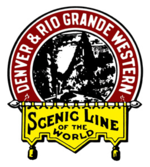This article includes a list of general references, but it lacks sufficient corresponding inline citations. (February 2011) |
 | |
 Map of D&RGW and WP routes (c. 1914). | |
| Overview | |
|---|---|
| Headquarters | Denver, Colorado |
| Reporting mark | DRGW |
| Locale | Colorado, Utah, and New Mexico |
| Dates of operation | 1870–1992 |
| Successor | Southern Pacific Railroad Union Pacific Railroad |
| Technical | |
| Track gauge | 4 ft 8+1⁄2 in (1,435 mm) standard gauge |
| Previous gauge | 3 ft (914 mm) |
The Denver and Rio Grande Western Railroad (reporting mark DRGW), often shortened to Rio Grande, D&RG or D&RGW, formerly the Denver & Rio Grande Railroad, was an American Class I railroad company. The railroad started as a 3 ft (914 mm) narrow-gauge line running south from Denver, Colorado, in 1870. It served mainly as a transcontinental bridge line between Denver and Salt Lake City, Utah. The Rio Grande was also a major origin of coal and mineral traffic.
The Rio Grande was a strong example of mountain railroading, with a motto of Through the Rockies, not around them and later Main line through the Rockies, both referring to the Rocky Mountains.
The D&RGW operated the highest mainline rail line in the United States, over the 10,240 feet (3,120 m) Tennessee Pass in Colorado, and the famed routes through the Moffat Tunnel and the Royal Gorge. At its height, in 1889, the D&RGW had the largest narrow-gauge railroad network in North America with 1,861 miles (2,995 km) of track interconnecting the states of Colorado, New Mexico, and Utah.[1] Known for its independence, the D&RGW operated the Rio Grande Zephyr until its discontinuation in 1983. This was the last private intercity passenger train in the United States until Brightline began service in Florida in 2018.
In 1988, the Rio Grande's parent corporation, Rio Grande Industries, purchased Southern Pacific Transportation Company, and as the result of a merger, the larger Southern Pacific Railroad name was chosen for identity.[2] The Rio Grande operated as a separate division of the Southern Pacific until 1992.[3] Today, most former D&RGW main lines are owned and operated by the Union Pacific Railroad while several branch lines are now operated as heritage railways by various companies.
- ^ "Home". railroadglorydays.com.
- ^ Robert A. Rosenblatt (August 10, 1988). "SP Is Allowed to Merge With Denver Rail Line : Decision by ICC Ends Battle Over Ownership of Carrier and Creates 5th-Biggest System in U.S." Los Angeles Times. Retrieved July 10, 2021.
- ^ "D&RGW Corporate History". DRGW.NET. March 19, 2006. Retrieved July 10, 2021.